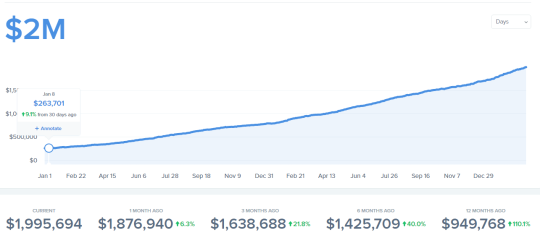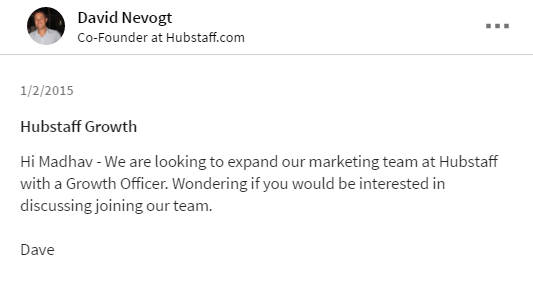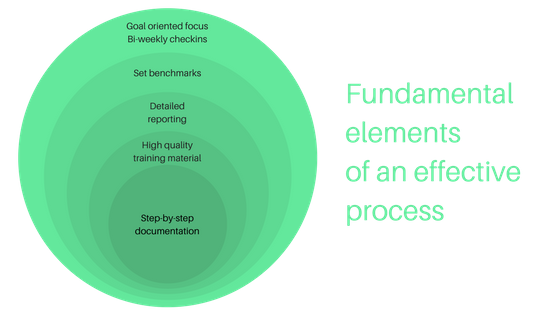
I’m so proud to announce that Hubstaff crossed $2M in annual recurring revenue this week. What makes this milestone even better is that we achieved it as a self-funded company with a bootstrapped budget. Our customers are our investors.
If you prefer listening to these lessons, I covered them in this podcast episode.
How it all started
Dave, my boss and co-founder of Hubstaff, connected with me in the very first week of 2015 to discuss if I wanted to join the team as a growth officer.

I did eventually join Hubstaff as their first full-time marketing hire. When I joined the team, our revenue was just $263,701. Two years later, we’re at $2M. That’s 658% revenue growth in TWO years. I’m so grateful we have come this far and that joining Hubstaff was a step in the right direction for me.
Over two years, we’ve seen numerous team changes – in fact our whole marketing team changed since then. We hired newer team members. From being employee #7, we now have a team of 35 people.
Fun fact: We’re a 100% remote team. None of us have ever met each other, yet. We finally met in Chicago in September 2017 and are making it an annual thing now.
Anyway, on reflecting in these 2 years of business, professional and personal growth, here are some valuable lessons that I’ve learned.
1. Have a team-wide focus on a common business goal
It could be a goal to increase no. of active users, revenue etc. It’s that one goal that is most important for the growth of your business and it should influence every little decision taken in the organization.
For example, at Hubstaff, our business goal for 2016 was to reach $140,000 in MRR by Dec 31 2016.
Every project, every task & every decision taken in each department was aligned towards achieving that goal. In support, a faster turnaround time would help us close more customers and reduce churn – which would help in achieving that goal. Prioritized. In marketing, agencies are our biggest customers – so our podcast for agencies was prioritized. In development, we wanted to improve the navigational experience around the app which would reduce our churn – so a UI improvement project was prioritized.
You need to have a common business goal in mind and all tasks must be aligned/prioritized to achieve that goal. This helps in achieving laser-targeted focus in achieving that goal. Here’s our mind-map for our 2016 goal (which we achieved 3 weeks early).

Recommended reading: http://blog.hubstaff.com/business-goals/
2. Nurture a culture of ownership
One of the biggest challenges I’ve faced as a manager is to make sure my team takes ownership of their tasks and successfully hits their goals. And not only that, but getting this accomplished independently and with minimum supervision from me.
I was able to do that by introducing KPIs in our team. Each team member has KPIs set according to the projects they’re responsible for. Then I make it a point to find a connection between their KPIs and our business level KPIs. Why? Because this will help team members see their impact on our business revenue and make their tasks more meaningful.
Here’s a simple example:

The moment your organization starts nurturing a culture of ownership, you’ll start seeing the best work happen from your team members. Embrace KPIs.
Btw I recently collaborated with Salesforce’s team to share my process of setting marketing KPIs. So if you want to read more about how I implemented these in our organization, check out this two-part post.
- https://www.salesforce.com/blog/2017/03/3-step-process-hubstaff-marketing-kpis.html
- https://www.salesforce.com/blog/2017/02/kpis-empower-employees-drive-results.html
3. Embrace the 80/20 rule in marketing and SCALE
Effective marketing channels come and go. I’ve learnt this from personal experience. Our most successful marketing strategy in 2015 is not even included in our 2017 marketing plan. Why? Because it’s effects died down. What matters is how much you utilize those marketing channels when they’re driving customers for you. In content marketing, content upgrades might be working today but 12 months from now – maybe not.
Here is our way of doing it: Just follow the simple 80/20 rule – 80% of your revenue is coming from 20% of your strategies. Double down on that 20%.
Once we identify our most effective marketing strategies, we test them on a slightly larger scale and see if it keeps driving similar results. If it does, we keep scaling the strategy until it’s not effective anymore.
I ask myself three questions to decide if a strategy is worth scaling or not.

Recommended reading: http://blog.hubstaff.com/developing-marketing-strategies/
4. Autonomous processes automate growth
Processes have always been the backbone of our growth engine. If there’s one thing that I’ve really learned in the last two years – it’s building efficient, effective & self-driving processes.
Once you have a tried & tested approach with a strategy, you can create & run processes with the help of a virtual assistant and really bring down the cost of a customer acquisition channel. Even better, the process can work autonomously so you can find time to work on newer projects v/s spending all the time managing.
The key aspects of a good process:
- Excellent step-by-step documentation – At each step of the process, you should ask yourself one question: is this step completed? And there should be only two answers to it: yes or no. This makes it easy for any other team member to follow the clear steps.
- Training manual with walk-through videos – So you don’t have to train newer team members again and again.
- Reporting sheet – So you can easily review the progress on the task.
I’ve built a number of our marketing processes from scratch including content amplification, link-building, sales outreach, integration partnerships etc. and each process is fundamentally built on these three elements.

5. Everything boils down to business revenue
I’ve talked with various entrepreneurs with goals like
- “We’re looking to grow our email list to 20,000 subscribers”
- “We’re looking to increase our users-base by 1.5x to 5000 users”
- “Our goal is to generate with 100k search traffic by end of this year”
These are good goals, but don’t ever forget that these are eventually sub-goals to the one goal that rules them all – business revenue growth.
People often lose sight of that. It’s great you want to build a 100K email list but what’s your conversion rate from emails now? Are you getting paid customers that are adding to your business’s revenue? With a bootstrapped budget, you need to focus 80% of your time on things that are driving your business revenue right now or in the next 3-6 months.
6. Patience
The most cliched advice, but probably the most important one of all. Don’t freak out if something goes wrong or things are not moving in the right direction. This is a part of the growth journey as well.
I used to freak out when a failure happened.
- An optin was not set up correctly and we lost out on all the traffic we got.
- Our domain’s spam score suddenly went up.
- Our search rankings were going down despite making all sorts of optimizations.
- All the A/B tests that I set up failed.
I get it – it’s demotivating as f**k. But that’s not what having a growth mindset is all about. This HBR article explains how a growth mindset is different from a fixed mindset.
“In a fixed mindset, you avoid challenging situations that might lead to failure because success depends upon protecting and promoting your set of fixed qualities and concealing your deficiencies. If you do fail, you focus on rationalizing the failure rather than learning from it and developing your capabilities. With a growth mindset, you focus on learning and development rather than failure and actively pursue the types of challenges that will likely lead to both learning and failure.“
Also after each failure, comes the need for patience. Be patient, hustle, learn and you’ll grow, your business will grow. I can’t even express how much I’ve learned from my mistakes to become a better marketer.
These were my top learnings in my last two years at Hubstaff. To wrap it up, we’ve had a great year and I’m looking forward to the next phase of our growth. We’re moving from being a single product company to a company with a suite of products and I’m so grateful to be leading one of the products this year onwards.
Here’s to bootstrapping, to SaaS, to empowering the customer & to the next million.





3 Comments
Great advice and insight for Saas marketing. What type of business would you say is your biggest and most ideal client?
Thanks Andrew – it’s definitely outsourcing companies and agencies.